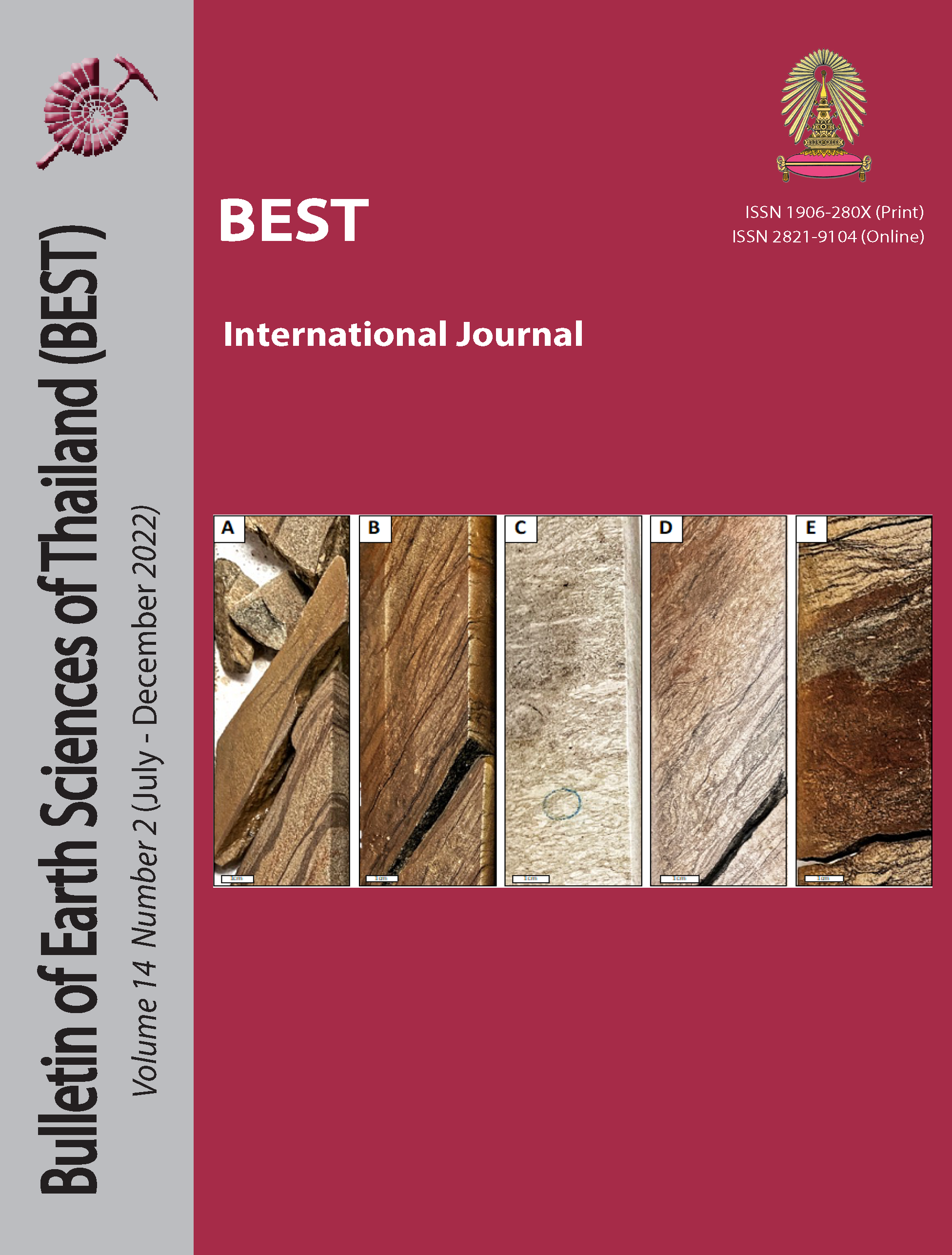Seismic characteristics and distribution of Neogene deep-water turbidites in East Coast Basin, Offshore Hawke Bay, New Zealand
Main Article Content
Abstract
This paper presents a seismic characteristics and distribution of Neogene deep-water turbidites in the Offshore Hawke Bay, New Zealand using 3D seismic data and seismic attributes analysis. Four main seismic facies were defined (facies A-D) within the Pliocene-Miocene interval. Additional horizons were interpreted to highlight possible turbidite depositional area. In the Miocene interval, the turbidite system pathways can be separated into three zones. First zone is the path where sediments are transferred from the SW high to the NE direction. The second zone is the pathway from N high. The third zone is located on the SE high, which was a paleo low. A simplify model of possible turbidite fairways was proposed with suggestion of the prospective location of turbidite fairways.
Article Details

This work is licensed under a Creative Commons Attribution-NonCommercial-NoDerivatives 4.0 International License.
Copyright © 2008 Department of Geology, Faculty of Science, Chulalongkorn University. Parts of an article can be photocopied or reproduced without prior written permission from the author(s), but due acknowledgments should be stated or cited accordingly.
References
Barnes, P., Nicol, A., and Harrison, T. 2002. Late Cenozoic evolution and earthquake potential of an active listric thrust complex above the Hikurangi subduction zone, New Zealand. Geological Society of America Bulletin, v. 114, no. 11, p.1379–1405.
Barnes, P., Lamarche, G., Bialas, J., Henrys, S., Pecher, I., Netzeband, G.L., Greinert, J., Mountjoy, J., Pedley, K., Crutchley, G. 2010. Tectonic and geological framework for gas hydrates and cold seeps on the Hikurangi subduction margin, New Zealand. Marine Geology, Volume 272, Issues 1–4, p26–48.
Bland, K., Kamp, P.J.J, Nelson, C.S. 2004. Stratigraphy and development of the Late Miocene-Early Pleistocene Hawke's Bay forearc basin. New Zealand Petroleum Conference Proceedings.
Brown, I., 2002, Kehe, Koheru and Hiwihiwi prospects. Ministry of Economic Development New Zealand. Open-file Petroleum Report 2939 Ministry of Economic Development, Wellington, New Zealand
Burgreen-Chan, B., Meisling, K. and Graham, S. 2015. Basin and petroleum system modelling of the East Coast Basin, New Zealand: a test of overpressure scenarios in a convergent margin. Basin Res 28(4), 536–567
Davies, E., Frederick, J., Leask, W., Williams, T., 2000. East Coast drilling results, 2000 New Zealand Petroleum Conference. Ministry of Commerce, Wellington, New Zealand, p. 11.
Dobbie, W.A., Carter, M.J., 1990. Te Hoe-1 well completion report PPL 38316. Ministry of Economic Development New Zealand petroleum report PR 1835.
Erdi A. & Huuse M., 2018. Tectonic Evolution and Hydrocarbon Prospectivity of East Coast Basin, Offshore Hawke Bay, New Zealand. OTC-28212-MS
Field, B., 2005. Cyclicity in turbidites of the Miocene Whakataki Formation, Castlepoint, North Island, and implications for hydrocarbon reservoir modelling. New Zealand Journal of Geology and Geophysics 48, 135-146.
Field, B.D., Uruski, C.I. 1997. Cretaceous-Cenozoic geology and petroleum systems of the East Coast region, New Zealand. Institute of Geological & Nuclear Sciences, Lower Hutt, New Zealand. Institute of Geological & Nuclear Sciences monograph 19. 301 p.
Francis, D.A., 1994. Reservoir formations in western and northern Hawke’s Bay, East Coast Basin, New Zealand. PPP38324, PPL38316. Petrocorp Exploration NZ Ltd. Ministry of Economic Development New Zealand Unpublished Petroleum Report PR2160.
Francis, D.A., 1995. Reservoir potential of the East Coast oil and gas province. Petroleum exploration in New Zealand news 45, 11-19.
Francis, D.A., 1998. The real oil and a bit of gas on East Coast reservoirs, 1998 New Zealand Petroleum Conference, pp. 207-221.
Francis, D., Bennett, D., Courteney, S., 2004. Advances in understanding of onshore East Coast Basin structure, stratigraphic thickness and hydrocarbon generation, 2004 New Zealand Petroleum Conference.
Griffin, A.G., Bland, K.J., Field, B.D., Strogen, D.P., Crutchley, G.J., Lawrence, M.J.F., Kellett, R., 2015. Reservoir characterisation of the East Coast and Pegasus Basins, eastern North Island, New Zealand, AAPG/SEG International Conference & Exhibition 2015. AAPG Search and Discovery, Melbourne, Australia, 13–16 September 2015.
Khamis, M. A., Jong, J. & Barker, S.M., 2018. Deformation Profile Analysis of a Deepwater Toe-Thrust Structural Trend - Implications on Structural Kinematics and Sedimentary Patterns. Bulletin of the Geological Society of Malaysia, Volume 65, June 2018, pp. 1 – 12.Mazengarb, C., Speden, I.G., 2000. Geology of the Raukumara Area: Institute of Geological and Nuclear Sciences 1: 250,000 geological map 6. Institute of Geological and Nuclear Sciences Limited, Lower Hutt, New Zealand.
Mortimer, N. 2004. New Zealand's Geological Foundations. Gondwana Res., 7(1), 261–272.New Zealand Petroleum & Minerals. 2014. New Zealand Petroleum Basins 2014/2015 Revised Edition. Ministry of Business, Innovation and Employment. www.nzpam.govt.nz
Paquet, F., Proust, J-N., Barnes, P.M., Pettinga, J.R. 2011.Controls on active forearc basin stratigraphy and sediment fluxes: The Pleistocene of Hawke Bay, New Zealand. GSA Bulletin; 123 (5-6): 1074–1096.
Pettinga, J.R. 1982. Upper Cenozoic structural history, coastal Southern Hawke's Bay, New Zealand. N. Z. J. Geol. Geophys., 25, 149–191
Strogen, D.P., Field, B.D., Browne, G.H., 2010. Petrography of sandstones from the Miocene Tunanui Formation, Hawke's Bay, New Zealand. GNS Science Report 2010/32. 49 p., Lower Hutt.
Totake, Y., Butler, R.W.H., Bond, C.E. &Aziz, A., 2017. Analysing Structural Variations Along Strike in a Deepwater Thrust Belt. Journal of Structural Geology.


